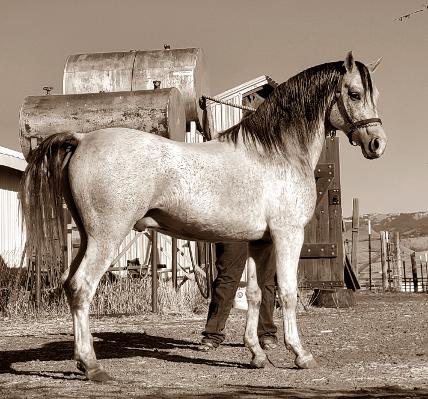
Royale Sumernitz
Pedigree Information
Royale Sumernitz is by the beautifully bred stallion Midsumernitzdream.
You don’t usually see the cross of an *El Shaklan daughter with a *Carmargue
son. Om El Arab’s most successful cross was of an *El Shaklan son on a *Carmargue
daughter. Midsumernitzdream is an example of how outstanding that this
cross really is and of what could have been if it would have been practiced
more. Midsumernitzdream’s sire NYN
Ndoto did very well in his show career under saddle in Country English
Pleasure until his death at an early age. NYN Ndoto was by the ethereal
World Champion stallion *Carmargue. *Carmargue was bred by Mr.
& Mrs. G T Greenwood of England. He was owned for most of his life by Mr.
Alun Prothero. In 1985 *Carmargue was exported to Spain. He was named
World Champion in 1985 with the highest points ever awarded at that time, and
Spanish National Champion Stallion in 1986. He was then exported on lease to
the US. *Carmargue introduced to the international community a new sire line
source of Skowronek through his most beautiful son Naziri.
Despite being a full brother to Naseem, Naziri was far more
alluringly beautiful and refined and those looks were passed to his offspring
all of which were said to have had an unusual, nearly ethereal elegance rarely
encountered. In her 1938 stud Lady Wentworth described Naziri as “The
most perfect Arabian stallion alive!” (Bearing in mind that all the most
prominent Skowronek sons were alive-never mind Nasik and other
equally famous Crabbet stallions!). In an interview with the “The Illustrated
Sporting and Dramatic News” on 31st of July 1936 she was emphatic
that, “…no money on earth would have bought the fine Arab Stallion, Naziri…..”
(she had recently sold horses to Russia and Spain). But it was Cecil Covey in
his last formal interview in 1984, who drove home the critical importance of *Carmargue.
Covey noted that Naziri was regarded by all that knew him “…as the most
beautiful Skowronek son-ever.” Covey went on and said, “*Carmargue
is a ringer for Naziri with a slightly improved hip and topline and with
an incredibly kind disposition (Naziri like *Mirage could be
quite lively whilst *Carmargue had a more Bright Shadow like
disposition!”). “Naziri was so treasured that Lady Wentworth was
terrified of something happening to him so she would not allow him off the
Crabbet property.” Despite all the precautions Naziri was killed at the
outset of WWII and had sired only 6 foals-5 fillies and 1 colt, whose blood was
comparatively unavailable until Burkan was acquired by Patrica Lindsay.
This was the Naziri grandson, by the Guiness family’s (Lord and Lady
Moyne) Saladin II, Burkan, who sired White Lightning – the
sire of *Carmargue bred by Glyn and Joyce Greenwood. On the other side
of *Carmargue’s pedigree, his dam, Velvet Shadow was by Bey
Shadow by Bright Shadow. Bright Shadow’s dam, Pale Shadow
was out of Shamnar, also by Naziri. Thus both sides of *Carmargue’s
pedigree carried the prepotent, though distant, Naziri blood. It is that
soft ethereal beauty and look that so frequently occurs in the Naziri
descendants via *Carmargue that makes him so extra special. (Note three
other prominent Arabians carry double Naziri though not on the sire
line: *Padron, Count Dorsaz and *Rushan AHSB!) Suffice it
to say, when it was discovered that there was such a stunningly beautiful horse
who brought a new line to the most internationally successful sire line of the
20th century, breeders around the world lined up to try to acquire *Carmargue
first from his breeders the Greenwoods and then later from Alun and Mary
Prothero- the Greenwood’s good friends who got *Cam when Mr. Greenwood
became critically ill. When a purchase proved unsuccessful, first Diego Mendez,
then Om El Arab International, and finally Paolo Gucci leased *Carmargue
and his sons and daughters have been snapped up as quickly as they were offered
for sale. Around the world such important breeding establishments as Halsdon
Arabians, Om El Arab International, Martenssons Arabians, La Aldara, Ses
Planes, Redwood Lodge, and the leading studs in Saudi Arabia, South America,
South Africa and Kuwait boast the blood of *Carmargue! When first seen *Carmargue
was said to be in the words of international trainer, judge and breeder, Paul
Atkinson, “….all that was best in his full brothers and sisters!” Quite a
compliment as all, or nearly all, *Carmargue’s brothers and sisters were
Champions in their own right and even had some international success. But none
had the impact of *Carmargue. In fact, it could be argued *Carmargue
was a genetic freak…an extraordinarily beautiful horse who not only stunned
crowds in the show ring, but was equally successful in the breeding barn. He never
sired a chestnut-only grays and bays. His grays like sons and International
winners WSA Charismma, Arazi, Om El Abadan and Ali
Khamsin are stunning, turning nearly white by the time they were three and
they all had an almost eerily ethereal quality of elegance and kindness. The
bays were as stunning but took much longer to mature into the beauties that the
gray siblings enjoyed…but oh what beauties they were and are. For example the
kindly *Carmagnole was often thought to be a small horse…until he was 7
and measured just at 16 hands with shoes!
More importantly, like the Skowronek sons of old, the *Carmargue
grandget are proving equally as important. For example the Australian bred
Junior World Champion Espano Estopa is making a significant impact in
Europe now. The most important thing to remember about *Carmargue was
what perhaps made him so successful, was that he was so incredibly kind. He
emitted a warmth, gentleness and kindness that was simply unparalleled. To know
*Carmargue was to know love and he passed that sweetness to all of his
sons and daughters. He was truly a miracle and blessing to Arabdom and so
remember: The next time you see an Arabian who looks like a fairytale come to
life-check the pedigree. It is probably a *Carmargue. *** Gari Dill-Marlow
NYN Ndoto was out of
the Spanish bred mare LA Sambra. LA Sambra’s sire was the
Champion producing sire El Tabal. El Tabal’s sire was the
beautiful stallion *An Malik. Foaled in 1970, bred by Juan M. Valerio of
Spain, *An Malik was imported to the US in 1972 becoming Class Winner 2
year olds, Champion Male Purebred Arabian and Supreme Show Champion All Breeds
at the Feria De Sevilla for the first WAHO meeting. *An Malik’s sire is
whom we think Royale Sumernitz resembles the most, the great Galero.
Galero is considered possibly the greatest sire of Spanish Arabians in
modern times. It is believed that he was stolen sometime during the night, but
despite a nationwide search, he was never found or seen again. Whatever
happened to this stallion remains a mystery. El Tabal’s dam was the
Canadian National Top 10 Mare *Taduria De Washoe.
Through *Alhabac, Royale Sumernitz carries a line to the gorgeous Reyna. Reyna was imported into Spain in 1930 by Cristobal Colon, Duque de
Veragua. She is considered a Spanish Tail Female mare, and is an exceptionally
beautiful daughter of Skowronek. Reyna was Champion at the Richmond show
in England as a yearling. She is dam also of Kashmir, one of Spain’s most important stallions. Also included from
*Alhabac, and additional lines in
the pedigree, is the Skowronek
daughter Jalila, dam of Nana-Sahib.
LA Sambra’s dam Mi Shadow was by the Spanish stallion *Barich De Washoe.
*Barich De Washoe was bred by Don Luis de Ybarra y Ybarra, Spain. He was
imported into the US en utero in 1965 by Andrew Steen. *Barich De Washoe
is a Canadian National Western Pleasure Reserve Champion. He is one of the most
influential and important Spanish sires in the breed, and with 483 foals, he is
ranked number one on the Top 10 list of leading Spanish sires.
Midsumernitzdream’s dam, CH Moniet, is by the 1977 British
Reserve National Champion Stallion, 1997 European and World Junior Champion
Colt, 1978 British National Champion Junior Colt, Brazilian National Champion
Stallion, 1983 US Top 10 Stallion and 1984 Canadian National Top 10 Stallion *El
Shaklan. Bred by Om El Arab of Germany, he was then exported to England,
then to the US in 1982, to Brazil in 1986, and lastly to Argentina in 1993 at
Zichy-Thyssen Stud. *El Shaklan was described by Sigi Siller, his
breeder, as having a face that was delicate and fine, like a filly’s face. *El
Shaklan is sired by the Straight Egyptian stallion Shaker El Masri
and out of the legendary mare *Estopa. Sigi Siller also goes on to
describe *Estopa. “*Estopa was a big mare for her time and stood
154cm (15.1+). She was a little long in the back. *Estopa had eyes that
were large and round and soft black. Her character was a contradiction of
terms. She could have, at times, the nature of a nurturing babysitter or the
fierce demeanor of a warrior. *Estopa was very people oriented and loved
being the center of attention. Shaker El Masri was much smaller, finer
boned, and somewhat standoffish. The combination of these two different
individuals produced offspring that were taller than both, more exotic than either,
with shorter backs and longer hips. It was my belief that *Estopa was
the dominant parent, with Shaker El Masri adding refinement and his dose
of fiery character. Together, *Estopa and Shaker el Masri
produced a new dimension of Arabian horse for Europe, a dimension that had
previously only danced on pages of books of artists or were frozen in bronzed
animation on coffee tables." ***Om El Arab
Shaker El Masri was a great
foundation sire for the world renowned Om El Arab. "In 1971 Sigi and her first
husband Heinz traveled to Egypt to shop for Straight Egyptian horses. At the
famous State Stud El Zahra they saw two of the most beautiful Straight Egyptian
stallions they had ever seen. The 1st was Alaa El Din and the
2nd was a chestnut stallion named Shaker. Shaker had a
beautiful body, a shapely neck with an elegant throat and a pretty face with a
fine muzzle. Sigi couldn’t believe it when Shaker was offered to them.
They bought him immediately and brought him to Germany. Sigi asked their
advisor, Dr. Amin Zaher, without whom this acquisition would not have been
possible, what ‘Shaker’ meant and he told her that it meant ‘thankful’.
She later added the two words ‘El Masri’ to Shaker’s name and the name Shaker
El Masri was created. It means ‘thankful to Egypt’. Shaker El Masri
together with his mate *Estopa shaped a new style of Arabian horse and
created a dynasty. Their offspring, *El Shaklan, Estawa, Estasha,
Estara and Ibn Estopa were so far ahead of their time and are
found in pedigrees of the majority of the successful show and breeding horses
around the world today. Sadly, Shaker El Masri’s life was cut tragically
short due to a freak pasture accident. Although he only had a few precious
years as a breeding stallion, the legacy he left behind and his contribution
and influence on the Arabian breed is nothing short of spectacular. The magic
of his cross with *Estopa circumnavigated the globe and forever altered
the look of the modern Arabian horse. Shaker El Masri was shown in 1973
for his first and only time, along with *Estopa in Germany. They both
earned ‘Top 10’s’. *Estopa enjoyed the experience, but Shaker El
Masri did not." ***Om
El Arab
Shaker El Masri is sired by the great Egyptian stallion *Morafic.
*Morafic’s dam was the beauty Moniet El Nefous. Moniet El Nefous was
considered one of the most significant Arabian mares in the fundamental history
of Arabian horse breeding. Born and bred in Egypt, she was suitably labeled as
“The Queen of the Nile” by erudite breeders. Her name though is translated as
‘wish of soul’. Bred at the Royale Agricultural Society in Egypt and sired by
the Ibn Rabdan son, Shahloul.
Ibn Rabdan was considered to be one
of the finest, good-looking breeding stallions of all time and was a preeminent
influential stallion in the breeding programs of the Royal Agricultural
Society. Carl Raswan considered Ibn Rabdan as a "world
champion" type. Jack Humphreys, who selected Arabians in Egypt for W
R Brown, described Ibn Rabdan as "almost perfect". Moniet El Nefous’ dam was the very
pretty mare, Wanisa, sired by Sheikh El Arab and out of Medallela. Of Moniet El Nefous’ 13 foals, these are her most influential
offspring in pedigrees today: Mabrouka
(x Sid Abouhom) the dam of the
immortal stallion *Morafic, Lubna (x Sid Abouhom) the dam of the great *Sultann who is sire of *Sakr+++,
Legion of Supreme Merit, and Makhsous, Mouna (x Sid Abouhom)
grand-dam of The Egyptian Prince, *Bint Moniet El Nefous (x Nazeer) imported to the US by Richard
Pritzlaff, *Fahker El Din (x Nazeer) imported to the US, *Tuhotmos (x El Sereei) was for many years the leading sire of Champions at the
Egyptian Agricultural Organization in Egypt and imported into the US, *Ibn Moniet El Nefous (x *Morafic) syndicated for a large amount
for his time of $4,000,000, *Soufian
(x Alaa El Din) imported into the US
by Gleannloch Farms, and Ameer (x Galal) sire of Marzouka.
*Morafic is sired by Nazeer. Nazeer was considered to be a very
good race horse, and was also very hot, and was heavily used at stud by the
Egyptian Agricultural Organization after the state took over the stud. He
outranked both his half-brother Sheikh El Arab and Shahloul. Nazeer
and Sheikh El Arab were both by Mansour; theirs is the most
important sire line in Egyptian breeding. Both stallions trace to important dam
lines: Nazeer to the dam line of Kamla and Sheikh El Arab
to the ancestors of Bukra. Nazeer was an impressive grey, not
very tall, standing under 14.3hh; a dry, correct horse with a fiery eye; very
masculine and with fine conformation. He sired stallions of equal quality. His
daughters Bint Bukra, Bint Moniet El Nefous and Bint Mabrouka
embodied the highest Arabian type and an unequalled refinement. However, it was
his sons who were taken more notice of. These mare families in particular,
became his best and truest heirs: *Morafic, Ibn Halima, Ghazal,
Hadban Enzahi and Aswan.
*Estopa is
sired by Tabal. Tabal is a Classical Spanish Semental Del Estado (S. del E.) bred
by Jose Maria de Ybarra. He was sold to the Cria Caballar in 1959 and certified
as a quality breeding sire for both their private use and at public stud. Tabal is one of the 2 principle sons of
Congo, the other being Zancudo. His son *Figuroso established important lines in Holland and the US. Tabal’s daughter *Estopa obtained worldwide renown for her extremely successful get
in Germany. Tabal was known for
siring horses with exceptional motion. Both Tabal and Zancudo were
stretchier and narrower than other Congo
get.
Also through his Spanish sire lines, Royale Sumernitz has 5 lines to Nana-Sahib. They are through his
daughters: Kantista through *Alhabac, Famula through Maquillo, the daughter Habladuria
through *Sabiduria, and twice the
daughter Egina through Malvito. Malvito
was widely regarded as the most influential sire of the late 1950’s. Nana-Sahib was stalled next to Barquillo in Spain. They both broke out
of their stalls one night and fought so viciously, no one could break up the
fight. Nana-Sahib broke both front
legs, ending up needing to be euthanized. Nana-Sahib
is by Razada. Razada was imported into Spain in 1926
by Cristobal Colon, Duque de Veragua. Razada
was trained in Haute Ecole and had such presence that he was most impressive. Razada had a very strong temper and did
not like everybody. When the Spanish Civil War started in 1936, the house and
horses of Valjuanete were expropriated. The soldiers could not handle Razada, and one day a soldier shot him.
Razada was Absolute Champion, All
Breeds, at the 1930 show with the Duke of Veragua.
*Sabiduria’s sire
was Maquillo. Maquillo was senior stallion at the National Stud in Spain in the
early 1960’s. One of his best sons was Saludo,
along with Sacudir, Uzacur, and Bambu. Maquillo was an
exceptionally well-conformed and beautiful stallion. His daughters Agata II, Baldosa, Betonica, Oromana, Dalia IV, and Garpa were
all excellent producers. ***AKS
Royale Sumernitz has 16 lines to the very influential Ursus. Ursus was imported into Spain by the Cria Caballar in 1912 through
France. Ursus was used only once on
a purebred by the Yeguada Militar and then was sold “Deshecho” to Jose Maria
Ybarra in 1928. He was initially used by the Yeguada Del Cid and the Yeguada
Casa De Marques Domecq. Domecq bred Sirio
III, which was coveted and finally purchased by the Duque de Veragua who
used him extensively. Such was the high quality of his get that Veragua sold
several stallions as breeding sires to the State Stud in Portugal. Ursus’ true potential came to the
foreground with the birth and subsequent sale of his son Gandhy to the Yeguada Militar in 1935. Gandhy had been bred by Jose Maria Ybarra, in spite of Ursus being marked deshecho, and is
known for his own sons: Tetuan (exported
to Argentina 1951), Maquillo, Malvito, and Habiente. Ursus himself
was not a large or tall horse, but he had a tremendous charismatic attitude.
CH Moniet is out of AZH Nabaska, a daughter of the
gorgeous 16.1hh athlete AZH Naborr. AZH Naborr is by the great
Russian stallion *Naborr and out of the Azraff and heavily Skowronek
bred mare Azhderiane. Azraff was a sire of numerous
winners including Comar Bay Beau+++ out of Rose Of Mirage (1968
Canadian National Champion Stallion and 1972 Canadian National Reserve Champion
Western Pleasure), Legion of Supreme Merit; Camiraff++ out of Veishea
(1969 US National Reserve Champion Futurity Colt), Legion of Merit; Galizon
out of Gay-Rose (1969 US National Champion Stallion); Lea Baron+
out of Lea Geymette (1973 US National Champion Futurity Colt), Legion of
Honor; AZA Destiny out of Bint Bass Hisan (1981 Canadian National
Reserve Champion). Azraff was grandsire of Gai Parada+++/ by Ferzon
out of the Azraff daughter Azleta, Legion of Supreme Honor and Supreme Merit. Extensive list of Top
10 Winners: Adios+++ out of Rose-Of-Cherry, Legion of Supreme Merit; AZA Destiny; Azrhand out
of Handeyna; Banouz out of Nejd Banou; Bolsoya Bachelor
out of Rapanzel; Camiraff++, Legion of Merit; Comar Bay Beau+++, Legion of Supreme Merit; Comar Bay Brummel++ out of Rose
Of Mirage, Legion of Merit; Comar
Dorrah out of Rafleymira; Comar Garnet out of Rafleymira;
Dar Es Salaam out of Al-Marah Indra; Gai-Apache out of Ga-Rageyma;
Gai-Gay-Rose out of Gay-Rose; Galizon; Gay-Rouge out
of Gay-Rose; Kanadea out of Karin; Kharaff out of Kharasaba;
Marqeza out of Marjura; Mirraff out of Mirzona; and
Rose Of Azraff out of Rose Of Comar.
Through AZH Naborr, Royale
Sumernitz has 1 line to *Mirage through the daughter Rigala.
Roger Selby’s main purchase in 1930 was *Mirage, an imported grey
stallion, 14.2hh, 1000lbs, three gated, sound, most gentle and lovable, of the
Seglawi Jedran Dalia strain, the most prized of the Seglawi strains. Lady
Wentworth described him as ‘a very showy good horse. Excellent legs, splendid
quarters and fine front. Very good in saddle, but too bouncing for English
taste as he gets English riders off.’ But this was not the reason *Mirage
was sold. Weatherbys had by now closed their Stud Book to new imports and
although Lady Wentworth tried to persuade them to accept *Mirage, she
was unsuccessful and therefore had no option but to sell him. Margaret
Lindsley Warden said of *Mirage: “now rated by many experts as the most
perfect specimen of the ancient elite or classic type in America…He stands a
scant 14.2hh, a sturdy model with the characteristic refinements of the best of
his breed. His head is a glory and his great eyes express high but gentle spirit
and gracious personality.” *Mirage was English Champion at the Richmond
Royal Show 1926, and American Champion at the National Arabian Show, Nashville,
TN 1934, at the age of 25. A most unique honor for a horse of such remarkable
age. Only one other horse, Mr. Selby’s mare Champion Rifala, holds the
same record of being both a British and American Champion.
AZH Nabaska’s dam Bazarab has produced successful horses
under saddle as well as in the Endurance field. Bazarab is by the Sport
Horse National winner producing stallion Bask Abtal. His sire is the
great *Bask++, his dam being the National Champion producer Rapsette.
Bazarab’s dam Zarhufa is by the US Top 10 English Pleasure and
National winning sire *Prince Zaim. His dam *Princess Zia was
Junior Female Champion 1955 in the UK before being exported to the US. Her sire
was the accomplished *Count Dorsaz. *Count Dorsaz was bred in
England and was imported into the US by Bazy Tankersley at Al-Marah Arabians.
He was the winner 2 times of the coveted Winston Churchill Award for the best
riding horse of all breeds. *Count Dorsaz is the only Crabbet stallion
to sire both a US National Champion (Count Bazy) and a US National
Champion Park Horse (Seahorse Duke Dorsaz). Zarhufa’s dam Ruhfa Nattall is
by the National Champion Masruf El Nattall, who’s sire El Natall was
the first Pacific Coast Champion Stallion.
Royale
Sumernitz’s dam is Rroyalee. Rroyalee is a 14.3hh
1015lb mare with a 71 ½ inch heart girth and 8 inch cannons. Rroyalee has been used primarily as ranch horse
outside of her broodmare duties. She has a very trainable mind and an abundance
of courage. Her qualities as a broodmare are wonderful, consistently producing
foals with improved physical characteristics over their parents. Rroyalee
is by the Endurance producing 16hh stallion Royale Bay. Royale Bay
himself was shown in a very brief arena career before he sustained a shoulder
injury limiting any more showing or a riding career. Royale Bay was
never out of the ribbons during his career. He was a very sweet stallion,
always happy to have children around him hugging his legs. He consistently
passed on this nurturing temperament to his foals as well. Royale Bay
produce several outstanding Endurance horses, among them being Paladin aka: Regalidon
(AERC#:H29619), and Edens Bay Rum (AERC#:16105), both very accomplished
endurance horses as well as both completing the Tevis Cup (Regalidon
placed 26th in 2000, 9th in 2001, and Edens Bay Rum placed 11th in
2002).
Royale Bay is by
the US and Canadian National Champion Hunter Pleasure AOTR and Top 10 Hunter
Pleasure Crown Royale, whose Halter wins include Regional Championships
and a Scottsdale Top 10 title. Crown Royale has sired such National
winners as Tollies Crown (who has 9 National wins including titles in Halter,
English Pleasure and Pleasure Driving), US National Top 10 Hunter Pleasure AOTR
and Show Hack Mr Royal+/, Legion
of Supreme Honor, US and Canadian National Top 10 Hunter Pleasure AOTR
18-39 GA Khemo Dacious, US National Reserve Champion Hunter Pleasure JTR
13/Under, US and Canadian National Top 10 Western Pleasure AOTR Bask Kaleed,
and Canadian National Reserve Champion Hunter Pleasure and Hunter Pleasure AOTR
18-39 Crown Regente+/, Legion of
Supreme Honor. Crown Royale was bred by Dr Howard Kale, one of
America's most innovative breeders who imported horses from England, Poland,
and Russia to create his breeding program.
Crown Royale is by *Bask++.
*Bask++ is the only stallion to be a US National Champion Stallion and
Park Horse and is the breed's all-time leading sire of Champions and National
winners, as well as National winner producers until recently. Bred by Albigowa
State Stud, Poland. *Bask++ began his race training in Poland at the age
of 2. He remained in the racing program for a full 4 years and out of 40 races,
he placed 1st 8 times, 2nd 7 times and was 3rd 7 times. *Bask was slated to be gelded, when Lasma Arabians chose to
purchase him. *Bask++ was exported in 1963 to Lasma Arabians, USA where
he became 1964 Scottsdale Champion Stallion, 1964 Scottsdale Champion Park
(3-gaited), 1964 US National Champion Stallion, 1964 US National Top 10 Park,
1965 Spokane Reserve Champion Park, 1965 US National Champion Park, 1965 was
awarded his Legion of Merit, 1966 Scottsdale Champion Park, 1967 US National
Reserve Champion Formal Driving, 1967 US National Reserve Champion Formal
Combination. Bred to very exclusive select mares, *Bask++ was given the chance to create a dynasty of Arabian foals
that would produce phenomenal athletes and Champions worldwide.
*Bask++ is sired by Witraz
who is sired by Ofir. Royale Sumernitz also carries 2 lines
to Wielki Szlem and a line to *Witez II, also by Ofir. Ofir was thought
to be the most valuable Polish breeding stallion produced between the World
Wars. Ofir’s body was very strong
and balanced. The fertility, hardiness, soundness and (in the case of the mares
that were generationally close to Ofir)
the propensity to be fabulous ‘milkers’ were factors that entered into the high
opinion with which Ofir was
regarded. Ofir’s neck was of
adequate length, but was somewhat heavy in general. His eyes, ears and general
dryness were first rate.Wielki Szlem
and *Witez II resembled Ofir more strongly than did Witraz. Witraz had a longer and better shaped neck than Ofir. His head was more attractive than
his sire’s, but his ability to sire unbelievably beautiful daughters and sons
that were noble if not beautiful was a phenomenon of the breed. The body of Witraz was a little longer than his
sire’s and his legs were not as clean. Witraz
was a little over 15 hands. Ofir was
a shade over 14.2 hands and Wielki Szlem
was just shy of 14.2 hands. Ofir’s
legs were quite good. Wielki Szlem
had a squarer frame than did Witraz.
His neck was definitely not as nice as Witraz’s.
Wielki Szlem had short, nicely
shaped ears and quite good eyes, but did not approach Witraz in terms of a general arresting quality of head. His head
was reported to be short, but pictures certainly show a generally boxy overall
shape. Wielki Szlem had very sturdy
and sound legs. The quality of his bone, still was not quite as clean as his
sire’s. Wielki Szlem was definitely
a shorter legged horse than Witraz
and did not have as long a forearm. The racing ability of the Wielki Szlem offspring as opposed to
the Witraz offspring was generally
superior, to a degree that was significant. Witraz was a fiery horse in possession of remarkable charisma and
capable of putting on a tremendous show when being trotted in hand. Wielki Szlem offspring could trot like
crazy, but he had a calmer temperament. This ability also translated well in
the saddle seat venues of the US. The Witraz
son *Bask++, certainly put an
irrevocable stamp on those classes as well so counts for a lot, but there is a
much larger sample of Wielki Szlem
offspring as opposed to Witraz get
to cite this demonstrable ability. Mr. Pankiewicz stated that Wielki Szlem was the more consistent
sire, while Witraz had a wider cross
section of quality in his offspring, but that was offset by the fact that Witraz had ‘not a few great’ horses as
well. The Wielki Szlem daughters
were often not glamour queens in the flesh, but their ability to give
absolutely first class direct offspring was off the charts.
Crown Royale is out of Canadian National Champion
Mare Jewel Drift, dam of 6 Champions including US National Top 10 Mare Crown
Amber. Jewel Drift is by the Crabbet import *Silver Drift,
sire of 18 National winners and over 25 producers of National winners. *Silver
Drift is a full brother to the all-time leading Crabbet sire of Champions, *Serafix,
and a maternal brother to US National Champion Park *Oran Van Crabbet. Jewel
Drift's dam, US National Champion Mare and National Reserve Champion
English Pleasure *Dornaba++, Legion of Merit, is a Polish import. She
produced only 3 foals, but all produced National winners. Her other foals are
Canadian National Champion Pleasure Driving Rossidor (sire of US
National Champion Western Pleasure Royal Lite+/, Legion of Supreme Honor) and Halter Champion Silver Monarch
(a full brother to Jewel Drift and sire of US National Champion Western
Pleasure El Silmon).
*Silver Drift’s sire was Raktha, a British Champion in 1948 and sire of numerous Champions
and National winner producers. Raktha
was foaled in 1934 at the Hanstead Stud and was purchased by Lady Wentworth in
1939. Raktha and Indian Gold (sire of *Serafix's dam *Serafina) were regarded as two
of the most important stallions at the Crabbet stud during World War II. Raktha traces back to Naseem and Skowronek and was an extremely
beautiful dark dapple grey, slightly heavy in body, but still deserving of the
British Champion Stallion Title at age 14 in 1948. Raktha was regarded as being
very different in temperament from his sire Naseem. Raktha was quiet and easy, a
type of horse that was good to take to a show. This stallion was regarded
as one of the very few perfect types of Arabian stallion. (The Crabbet
Arabian Stud, Its History & Influence by Rosemary Archer, Colin Pearson,
Cecil Covey). Raktha is
also known for his progeny besides *Serafix,
such as his famous sons General
Grant out of Lady
Yules' Samsie, and Indian
Magic out of Indian
Crown. His famous daughters were Silverlet (out of Silver Gilt) who went to South
Africa along with Bint Razeena. Another
daughter, *Silwa, is an
American Halter Champion and dam of 4 Champions. *Silwa produced *Silwara, a dam of 4 National
winners including the Canadian National Champion Stallion Tornado++,
Legion of Merit. Other famous sons include *Silver Drift (full brother to *Serafix) and Indian Magic, a British
National Champion Stallion.
*Silver Drift’s dam was
the ethereal mare *Serafina, a highly regarded mare of the Crabbet
Stud farm of the post-World War II era. *Serafina was foaled in
1945 and was considered one of the great mares that led to the resurgence of
the Crabbet Stud after the war. *Serafina’s sire, Indian Gold,
was one of Crabbet’s premier stallions. Lady Wentworth’s breeding program was
rooted on the crossing of the Mesaoud and Skowronek bloodlines
whenever possible. Not all of Lady Wentworth’s stallions were shown to gain
notoriety. Travel was largely by rail and to risk valuable bloodlines to injury
or worse was not worth it. One of those stallions that was not shown was Indian
Gold, being tail male descendent of Skowronek through *Raswan
and Ferhan, this stallion gained his value as a sire through his
offspring and particularly through his daughters. *Serafix was *Serafina’s
first foal and *Silver Drift was a full brother; both were sired by Raktha
and imported to the US. *Serafina was over 15 hands which was felt to be
due to several crosses to *Nureddin. She was a brilliant, iridescent
chestnut which she bequeathed to *Serafix. She had very little white. A
quote out of The Arabian Horse, September 1976, an article by Dick Warner,
comments on *Serafina: “She is exceptionally good up front with a very
long neck, well joined on; good withers and a typy head. She is elegant. She
has a deep hip and good legs and a splendid top line. In short, she is an
excellent Arabian mare, with few obvious faults of conformation or type.” *Serafina
was sold in 1960 to Mr. S G Bennett of Georgetown, Ontario and foaled *Bright
Gold in 1961. Mr. Bennett continued breeding *Serafina on his
Arabian farm and she was later purchased by Mr. Paul Brown in 1970. *Serafina
had her last foal in 1972; she lived to be 31 years old and died July 12, 1976.
*Dornaba++ is
sired by the incomparable *Naborr. *Naborr is one of 8
World Sires of Significance who have sons who are Sires of Significance. (*Gwalior, *Aramus, Kaborr+++, and Gai-Adventure). In 1954 *Naborr
was named Reserve National Champion at the All Union Agricultural Fair in
Moscow. (Winner of that class was his sire, Negatiw.) *Naborr
sold at age 19 for $150,000 and in 1963 *Naborr was imported to USA by
Anne McCormick, traveling on the same boat with *Bask++.
*Naborr is by the great Russian stallion Negatiw. Negatiw
was bred by Tersk Stud, Russia. He was 50% Crabbet. Exported to Poland in 1962
and was a race winner in Poland. Race record: 1/4 (2-0-0). Sire of many Race
winners. Negatiw's sire line was Ibrahim and his dam line was Gazella
DB. Negatiw was 1954 Russian National Champion Stallion. He was
credited as the stallion that returned the Ibrahim sire to Poland. Negatiw
remains highly regarded around the world as the most internationally
influential grandson of the immortal Skowronek. Though bred in Russia, Negatiw
was from predominantly Polish bloodlines as his dam was a Janów Podlaski
confiscate from the Second World War. As a considerably successful sire at
Tersk, Negatiw was greatly desired by the Poles for many years. He was
finally obtained at age 17, standing in Poland for another 10 years with
outstanding results. Having already sired international Sires of Significance *Salon
and *Naborr in the USSR, Negatiw left Poland with the immortal *Bandos
PASB and a host of wonderfully typey, ultra-refined and extraordinarily
feminine broodmares. Director Krzysztalowicz described Negatiw as
'extremely dry and refined, with a small, chiseled head accented by beautifully
large, dark and luminous eyes and small ears. His legs were relatively correct
(though slightly sickle-hocked) and his back and topline were strong and a bit
long. As a stallion, he was strikingly refined and distinguished - he
represented a rare example of perfection.'
Royale
Bay is out of the Mekeel bred mare MHR Port Baja. MHR
Port Baja's sire is Port Bask, the leading sire of Champions by *Bask++.
Port Bask is pure Polish. He was considered to be the best producing *Bask++
son and was especially known for passing on his extreme athletic ability. Port
Bask produced many outstanding show horses such as: Sierra Baskita,
US National Top 10 Mare in Halter; Portaleah with Regional wins in
English Pleasure and Country English Pleasure; Portallasa, a National
Champion producing dam; the Dressage stallion MHR Sabre; MHR Port
Macja, listed as the top Arabian mare in the US and the World; MHR Port
Giesha, multiple Regional wins in English Pleasure, Park, Sidesaddle and
Halter.
Rroyalee's
dam is Debbani Al Hadiye. She is 14.2hh with a big body, deep girth and weighing
in around 850lbs. Debbani Al Hadiye
is an exceptional broodmare, producing outstanding foals far better than she
and the stallion she is bred to. Along with her broodmare duties while at
Double Starz Ranch in Utah, she was the main riding horse for any new comers to
horses or Arabians alike. Her temperament and characteristics are that of the
desert Arabians brought straight out of the desert. She is every bit a war
mare, always protecting her rider from any threat, and though she is small, she
has the heart of a warrior. Debbani Al
Hadiye has large black feet, solid dense bone, dry chiseled desertbred
features on her elegant face, with the thin black skin so rare in the breed
anymore. She was used as an outcross mare while at Double Starz Ranch and did a
phenomenal job. She was then sold to Sundance Farm in Oregon and was bred
strictly Blue Star while there, preserving her heritage. Debbani Al
Hadiye is a
Blue Star, Asil, Al Khamsa mare, Tail Male: Jamil El Kebir (APK), Tail Female:
*Al Hamdaniah. She is linebred to the desert horses *Fadl, *Turfa
and Sirecho.
*Fadl was
bred by Prince Mohammed Ali, Manial Stud, Egypt, imported from Egypt to US in
1932 by Henry B Babson, Chicago, Illinois. Sire of 74 registered purebred
Arabian foals (34 of which were Straight Babson Egyptians). The stallion *Fadl
was used as a Polo pony and as an Endurance mount, besides being a successful
show ring competitor in both Halter and Performance, as well as working on the
farm pulling the feed wagon and manure spreader. Modern Arabian breeding owes
much to the Babson Egyptian imports. The breed’s all time leading sire of Champions,
Afire Bey V, traces to the Babson stallion *Fadl, as do US
National Champion Stallions and influential sires Khemosabi++++//, Legion of Master and Excellence, and
Ali Jamaal, multi-National Champion Park Aequus+/, Legion of Supreme Honor, *Simeon
Shai+ (the only stallion to ever be named US and Canadian National Champion
Stallion and World Champion Stallion), Legion of Honor, multi-National Champion
Dressage El Bahim Halawa+,
Legion of Honor, and multi-National Champion English Pleasure Empress
Of Bask, to name just a few prominent horses who carry the Babson
influence. Of *Fadl's 74 registered get, 34 were Babson Egyptian. 11 of *Fadl's
get produced National winners. The 6 *Fadl sons who have sired National
winners are: Fa-Serr, Fabah, Ibn Fadl, Fa-Turf and Fadheilan
(sire of twice US National Reserve Champion Stallion Fadjur, one of the
most influential stallions in American Arabian breeding in the 20th century). *Fadl's
National-winner producing daughters are Arafay, Fa-Rahna, Dinah,
Faaba and Turfara. *Turfa was bred
by the Saudi Royal Family (His Majesty King Ibn Saoud)
in the Royal Stud at Khorma, Nejd - Central (Saudi) Arabia. Strain: Kuhaylat
al-Ajuz, from the stud of Al Khorma in Saudi Arabia. She was presented to King
George VI of England as a coronation gift in 1937. Henry B Babson acquired her
from the Prince of Wales and imported her into the US in 1941.
*Fadl was by Ibn
Rabdan, one of the most popular and heavily used stallions in Egypt. Carl
Raswan considered Ibn Rabdan as a "World Champion" type.
Jack Humphreys, who selected Arabians in Egypt for W R Brown, described Ibn
Rabdan as "almost perfect". *Fadl's dam, Mahroussa,
was epitomized as one of the most beautiful mares of her time. Mahroussa
was the daughter of Mabrouk Manial and Negma, both classic Arabians
of exceptional quality. Mahroussa also produced such horses as *Zarife,
*HH Mohamed Alis Hamida, *HH Mohamed Alis Hamama and *Maaroufa,
*Fadl's full sister.
Sirecho was
regarded by Carl Raswan as having gone down in American-Arabian history as one
of the important foundation sires. Also stating that he is one of the few who
have become responsible for salvaging the completely PURE Arabian in America
from extinction. Because of his acquisition by Mrs. Ott, Sirecho became one of the few sources of Straight Egyptian lines
which remains an outstanding outcross for most pedigrees in which more popular
Egyptians were used far more frequently and far less judiciously. He was not
stood at public stud, Mrs. Ott handpicked the mares bred to him resulting in a
relatively small, but high quality band of foals. A family of remarkable
longevity, they are also highly prolific, still producing easily into their
late twenties. As beautiful as they are athletic, the Sirecho descendants speak for themselves: Joramir 1968 US Top 10 English Pleasure and Native Costume, 20
Class A Halter and Performance Championships; Jora Honey Ku 1978 Canadian National Champion; VP Kahlua 1984 US and Canadian National Champion Mare; AK Sirhalima Australian Leading Sire of
Champions; Anchor Hill Halim German
multi Champion and Endurance winner; Anchor
Hill Omar South African National Champion; Anchor Hill Annah US Top 10 Trail Champion; Ses Khebira Egyptian Event and Salon Du Cheval winner; *Simeon Shai US and Canadian National
Champion Stallion, along with such notables as Glorietta Gaazal and Akid
Geshan. The black Sirecho
granddaughter Shar Gemla is
influential in pedigrees of many black show Champions of the Arabians of “The
Black Stallion” movie fame.
Sirecho’s dam, *Exochorda (also known as Leila II and Marquita in Egypt) was known as a beautiful, powerfully built, and
exceedingly correct Purebred Arabian racing mare. Much controversy swirls
around her importation, birth date, and even her entries in the RAS. Few, if
any, can deny the impact she had on the Arabian breed. *Exochorda was a Saqlawi mare born in Egypt in the early part of
the 1920’s. A demure mare, she stood only 14.2 hands high and weighed about 825
pounds. Her sire, the stallion known as Aiglon,
and her dam, Leila I, were both pure
desertbreds who had been imported into Egypt directly from the Arabian desert
by private breeders. According to Carl Raswan, both parents were acquired
through the Argheyl Muhammed Ibn Marzuki of Bureyda Quasim. All three, Aiglon, Leila I and Leila II,
raced in the Purebred Division on the Cairo racetrack, under the scrupulous eye
of the Jockey Club Committee, headed by Dr. Branch. Raswan stated that Prince
Kemal El Dine “used to call *Exochorda
(Leila II) the female counter-part
of Mesaoud”.
Sirecho’s
sire, *Nasr, was imported into the
US in 1932 by Mr. W R Brown. *Nasr
was bred by Prince Mohammed Ali. He was a stunning white bold and powerful
stallion.*Nasr had a remarkable
racing career in Egypt prior to his importation. Standing 15 hands high and
weighing 1,000 pounds, he is recorded as having a girth of 70 inches with 7.5
inches of bone. His foals were exported to countries all over the world,
including England, Brazil, Guatemala, Columbia and Venezuela.
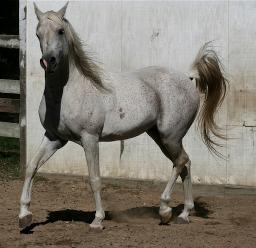
Midsumernitzdream
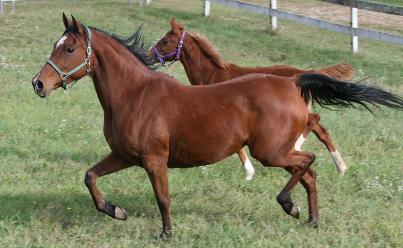
Rroyalee
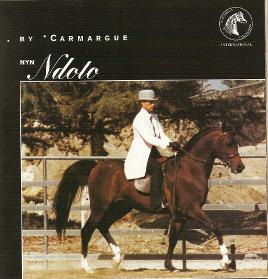
NYN Ndoto
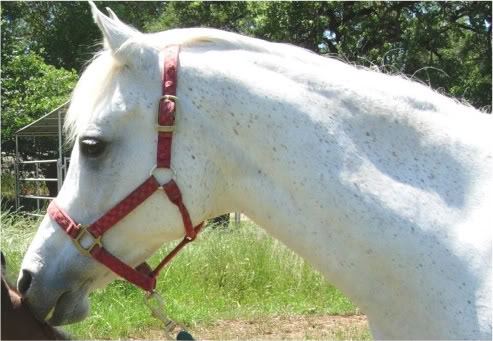
CH Moniet
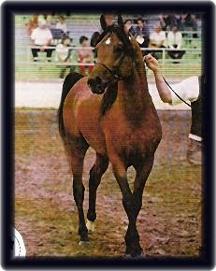
Royale Bay
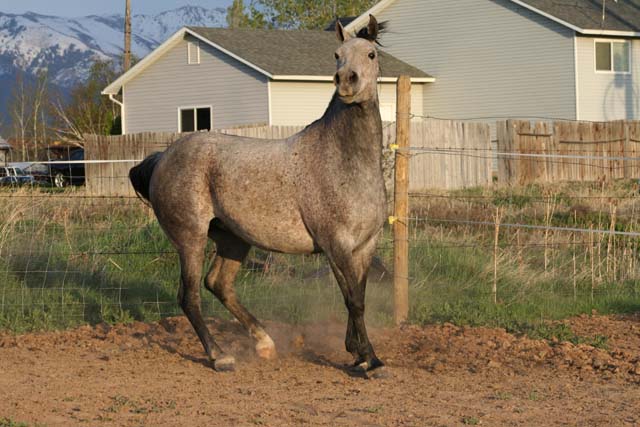
Debbani Al Hadiye
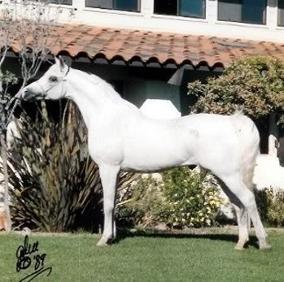
*Carmargue
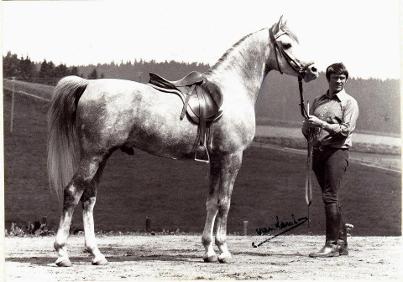
*El Shaklan
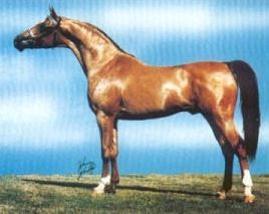
Crown Royale
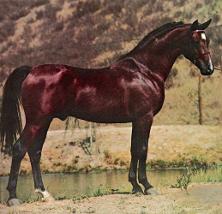
Port Bask
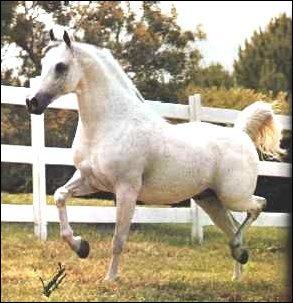
*An Malik
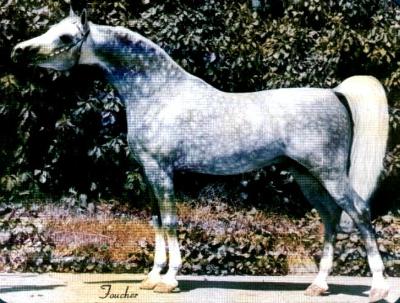
AZH Naborr
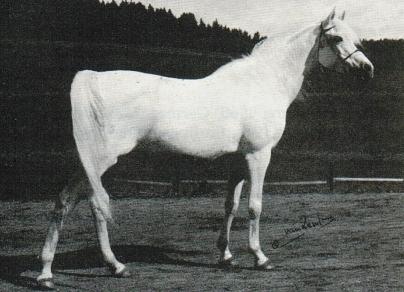
*Estopa
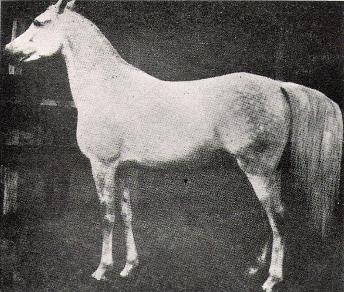
Mahroussa
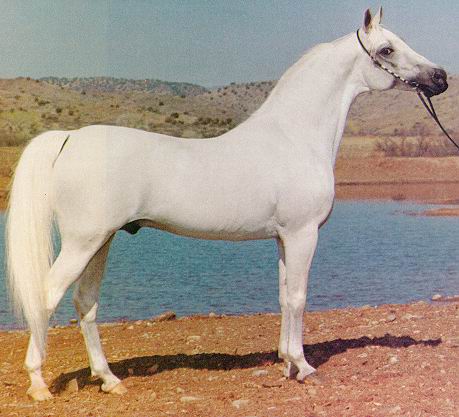
*Naborr
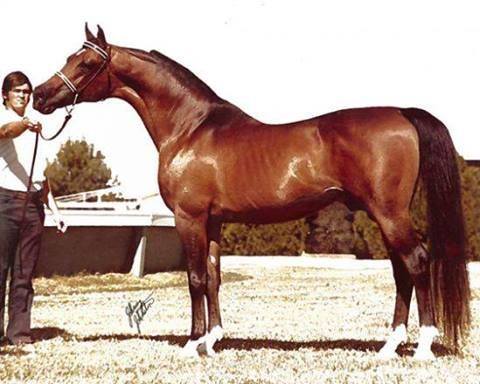
*Bask++
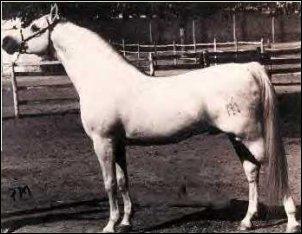
Galero
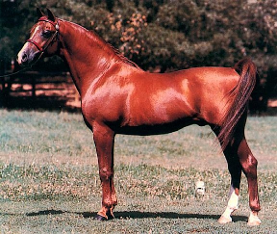
*Barich De Washoe
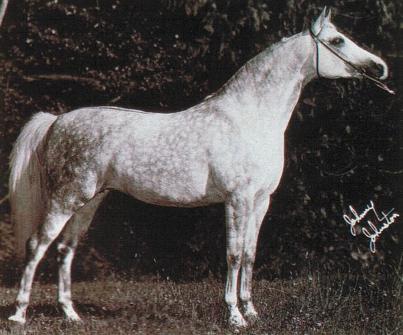
*Dornaba++
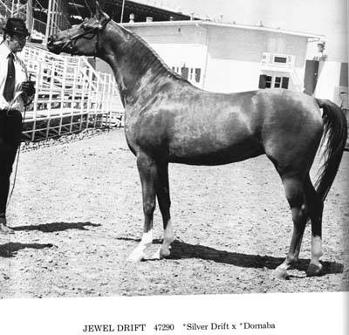
Jewel Drift
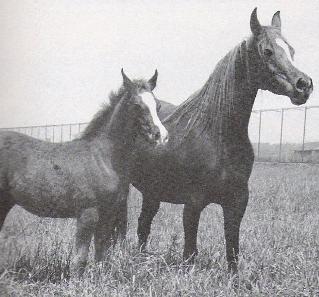
Ghazna
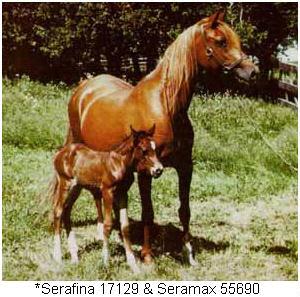
*Serafina
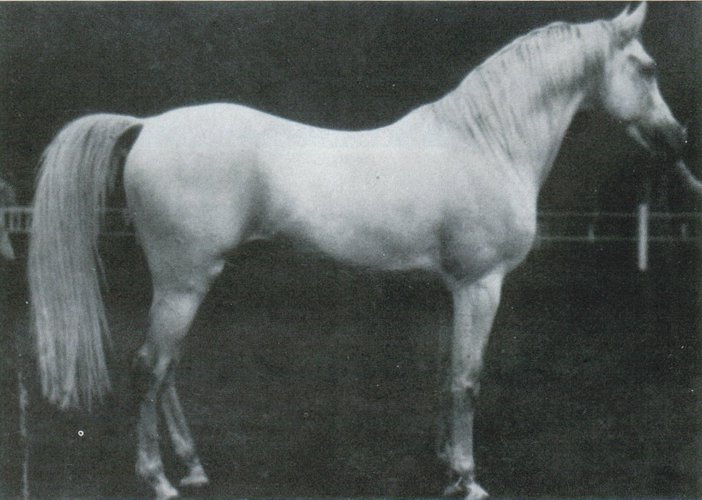
*Nasr
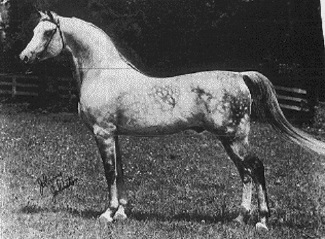
*Silver Drift
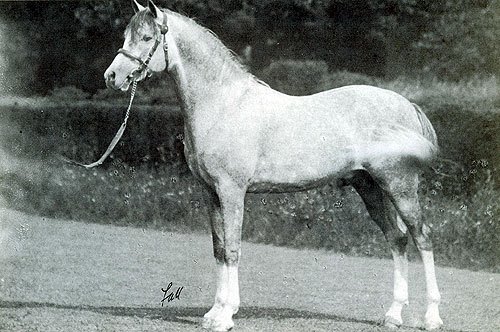
Naseem
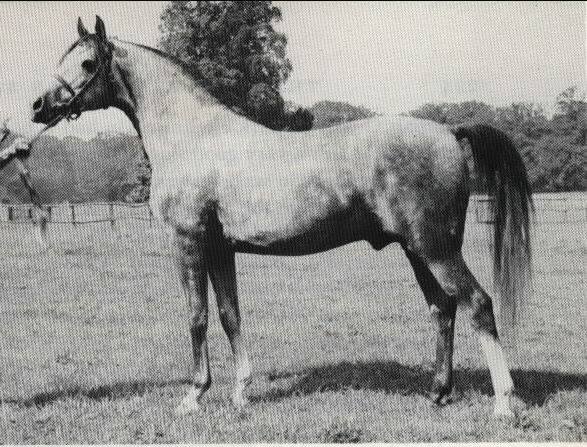
Raktha
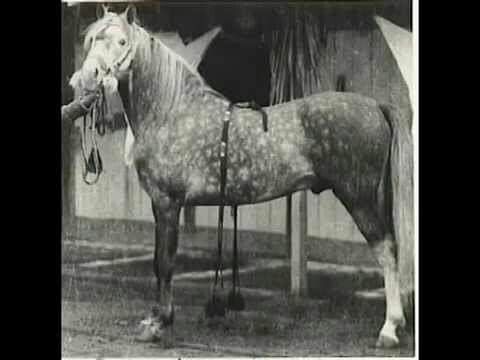
*Raswan
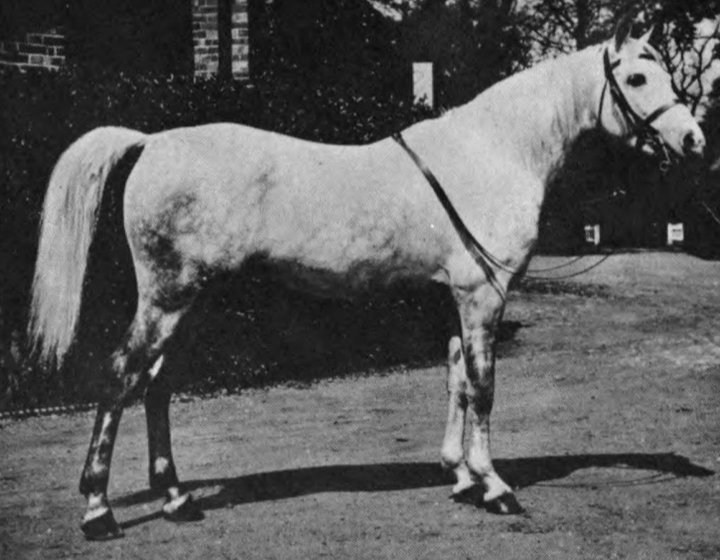
Skowronek
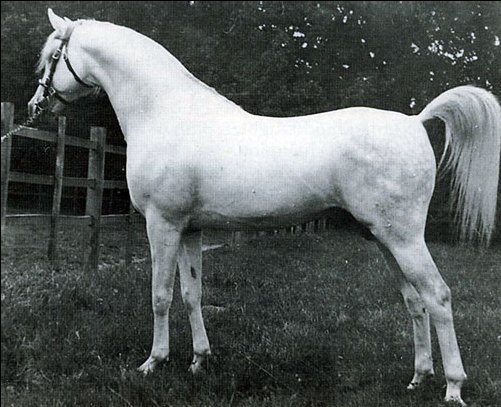
Naziri
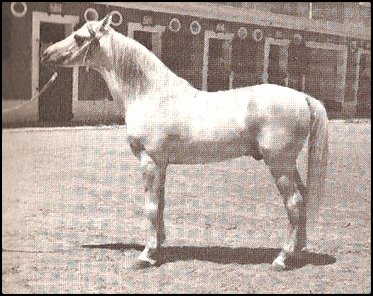
Tabal
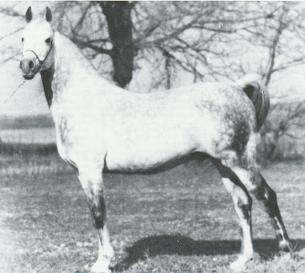
Azraff
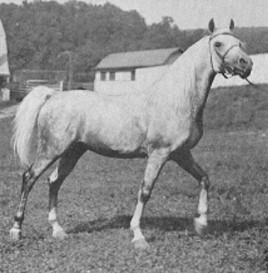
*Raffles
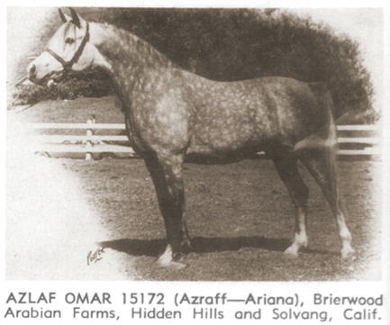
Azlaf Omar
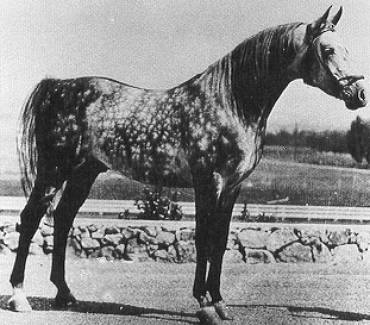
*Raseyn
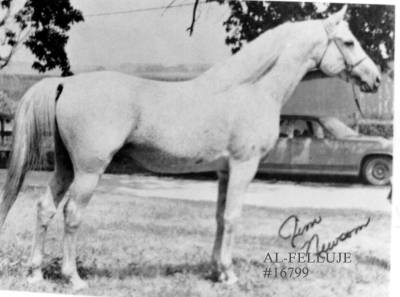
Al-Felluje
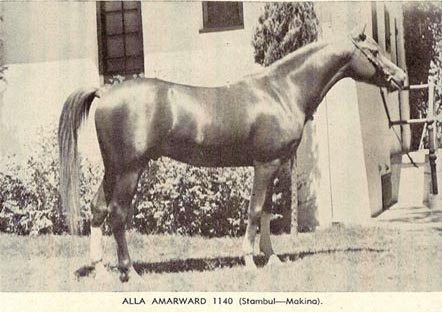
Alla Amarward
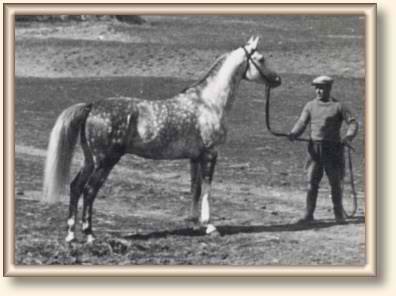
Amurath-Sahib
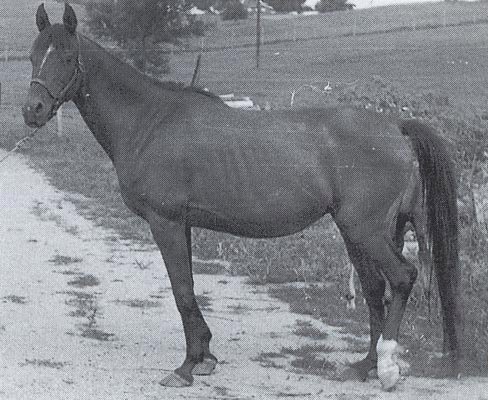
*Azja IV
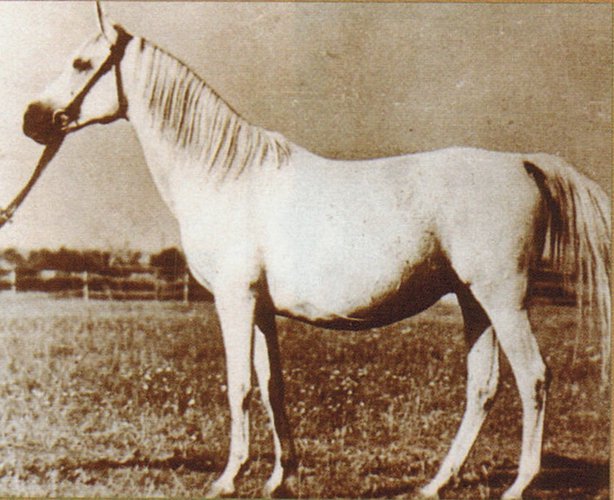
Balalajka
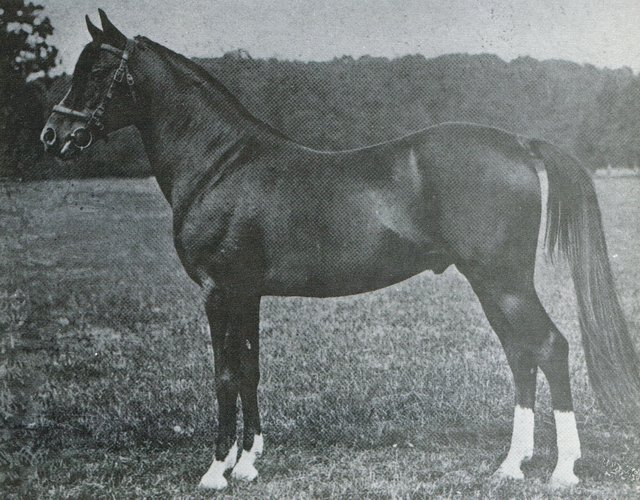
*Berk
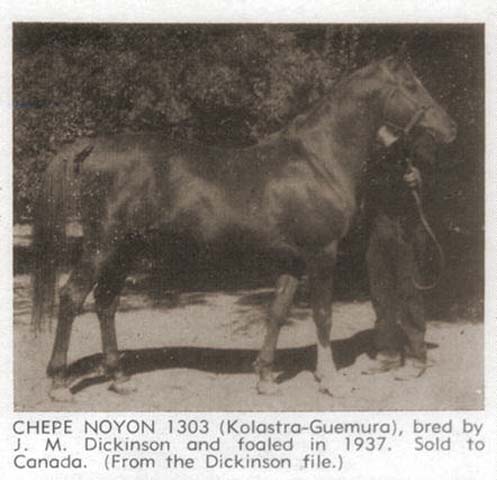
Chepe Noyon
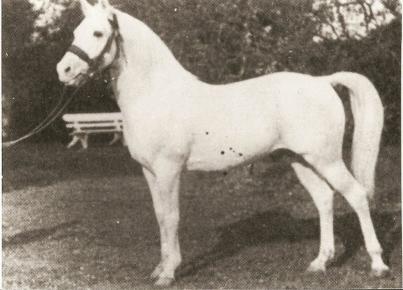
Congo
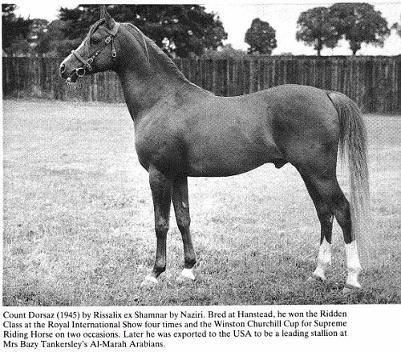
*Count Dorsaz
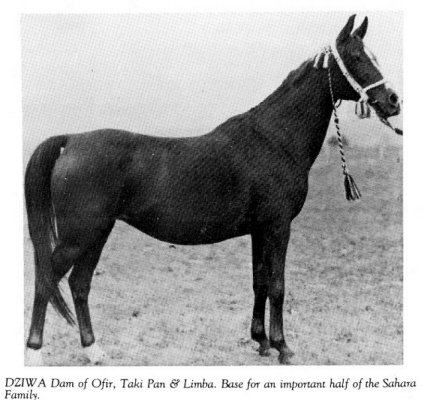
Dziwa
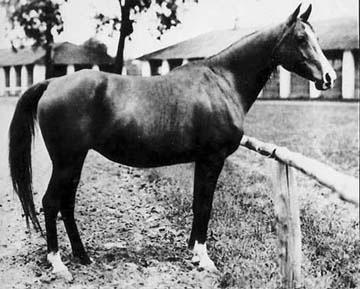
Elegantka
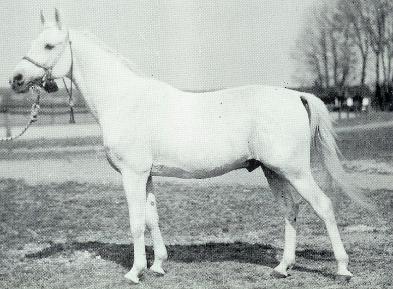
Enwer Bey
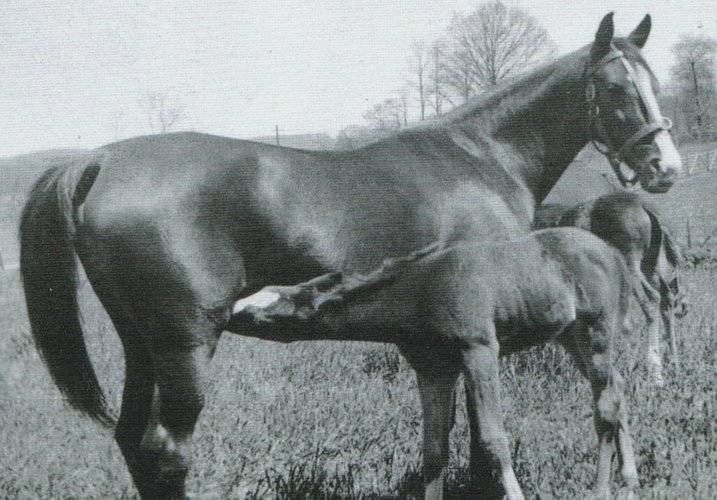
*Exochorda
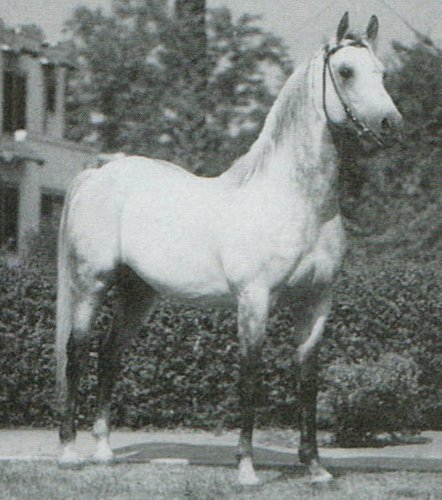
Ferseyn
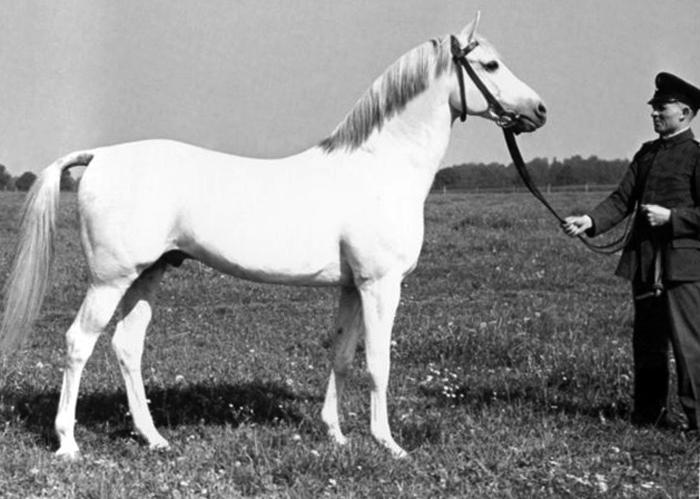
Fetysz
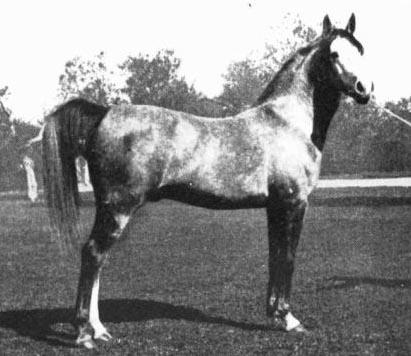
Gandhy
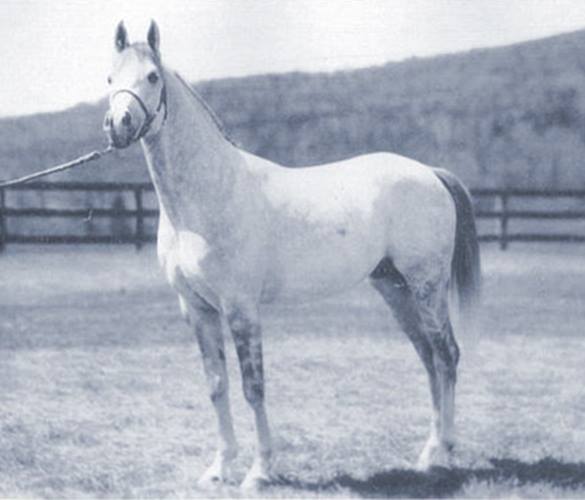
Ghazi
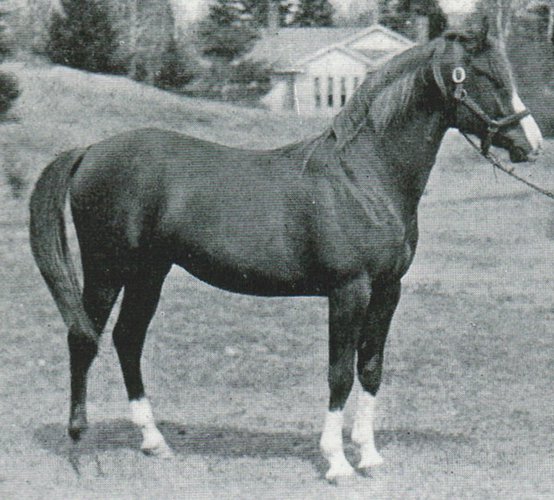
Gulastra
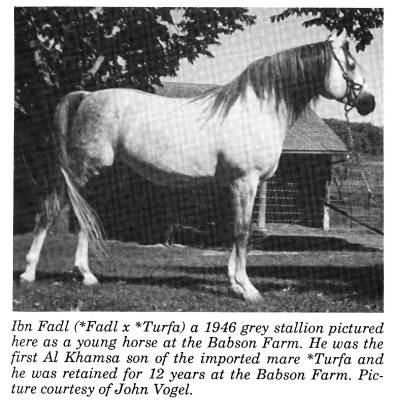
Ibn Fadl
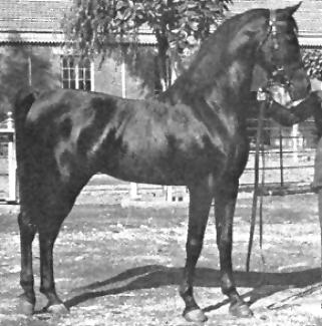
Ibn Rabdan
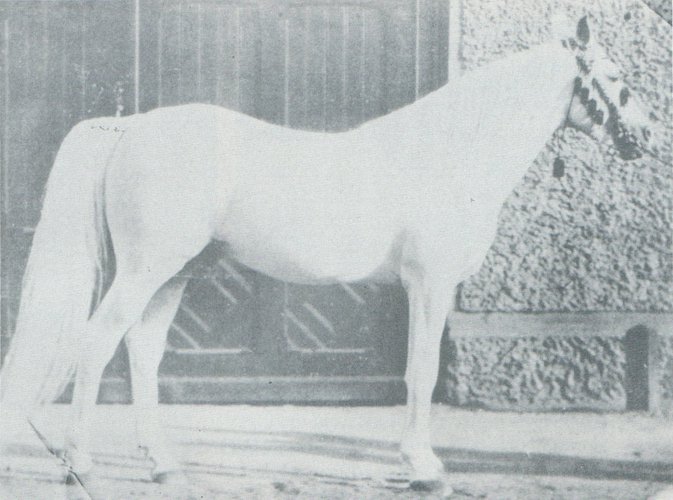
Ibrahim
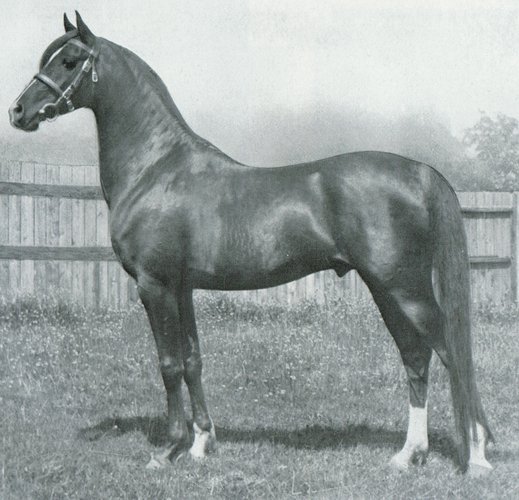
Indian Gold
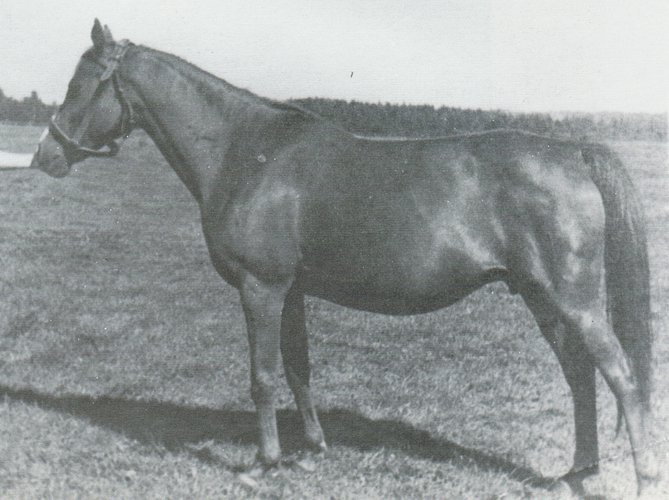
*Iwonka III
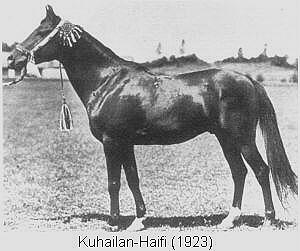
Kuhailan-Haifi
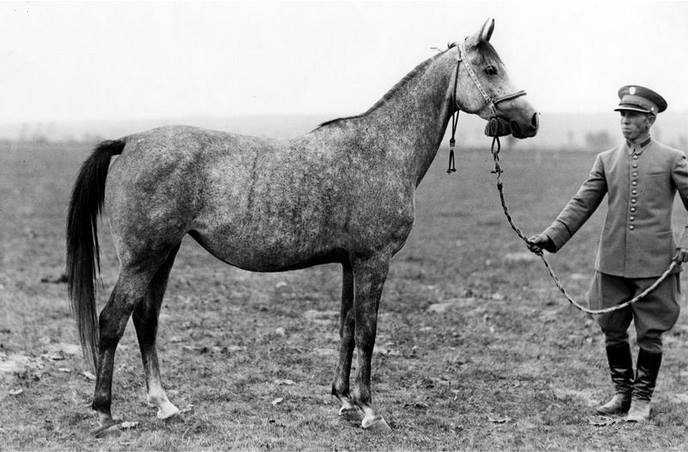
Makata
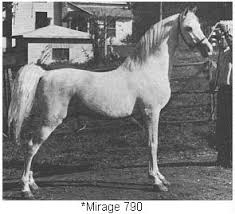
*Mirage
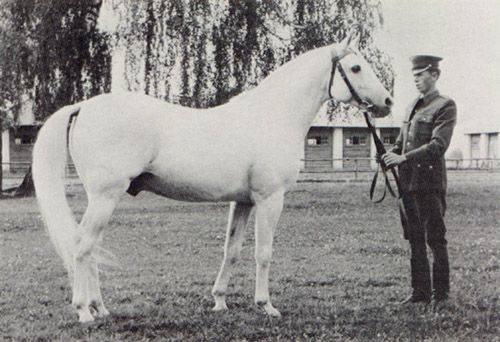
Negatiw
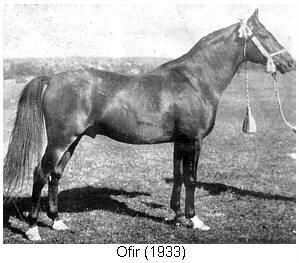
Ofir
Pomponia
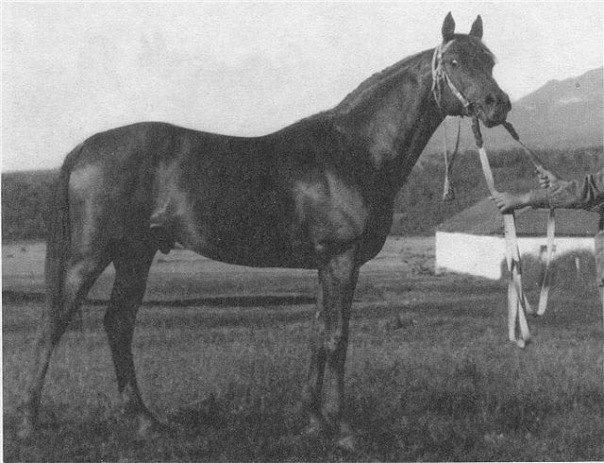
Priboj
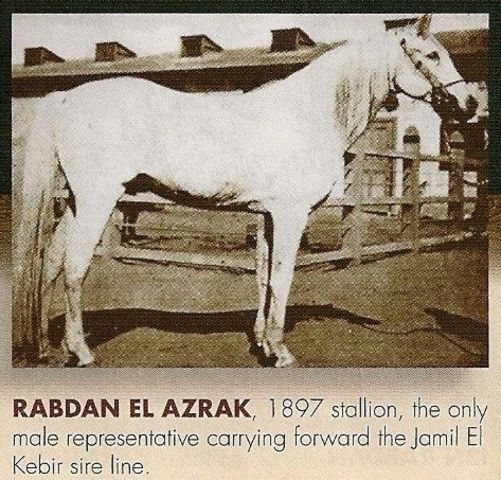
Rabdan El Azrak
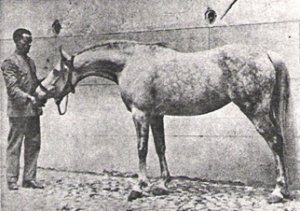
Reyna
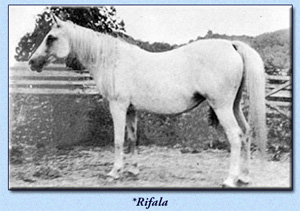
*Rifala
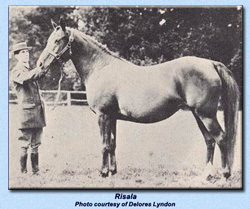
Risala
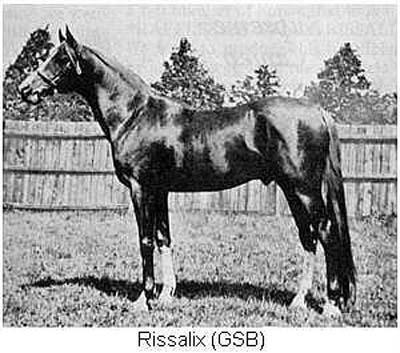
Rissalix
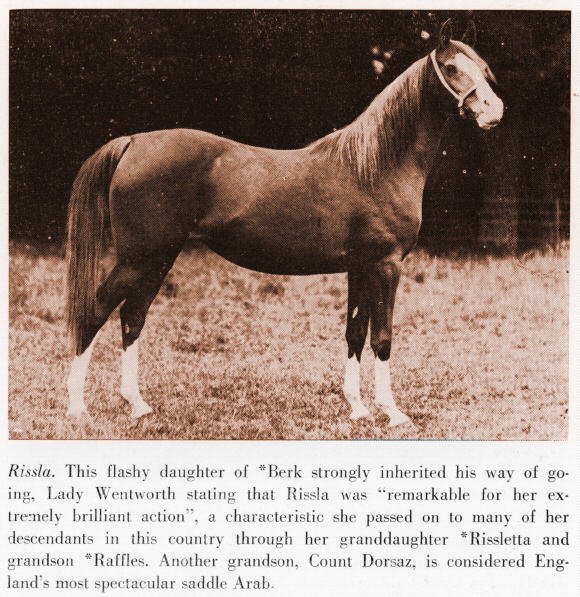
Rissla
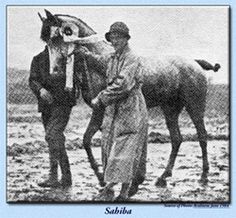
Sahiba
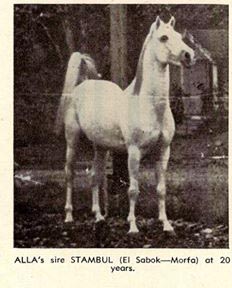
Stambul
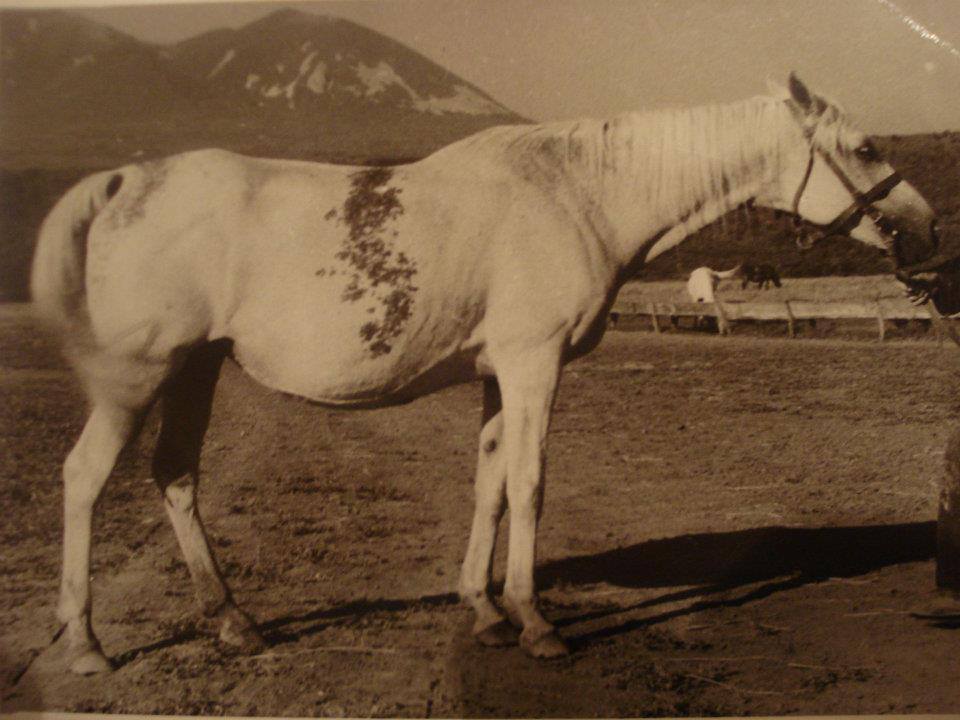
Taraszcza
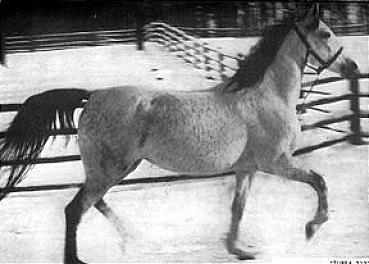
*Turfa
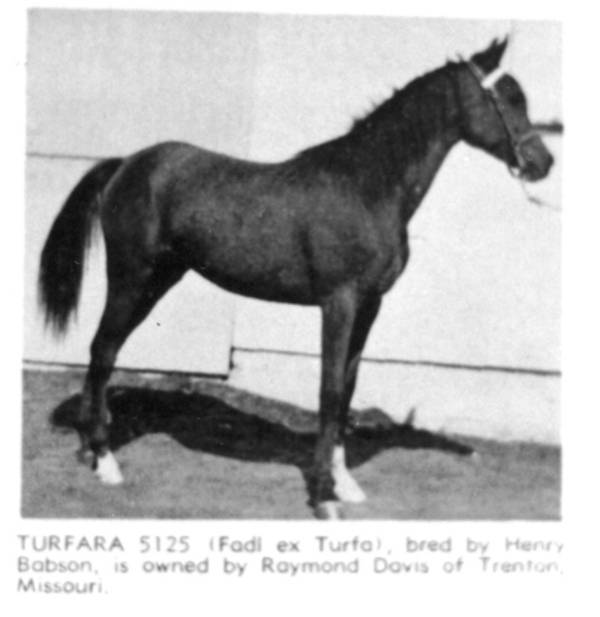
Turfara
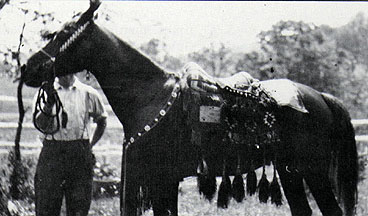
*Wadduda
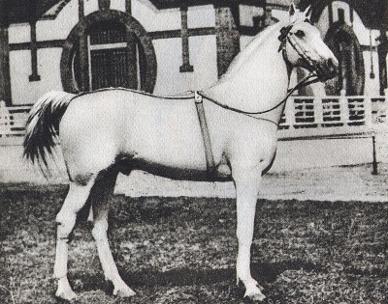
Wan Dyck
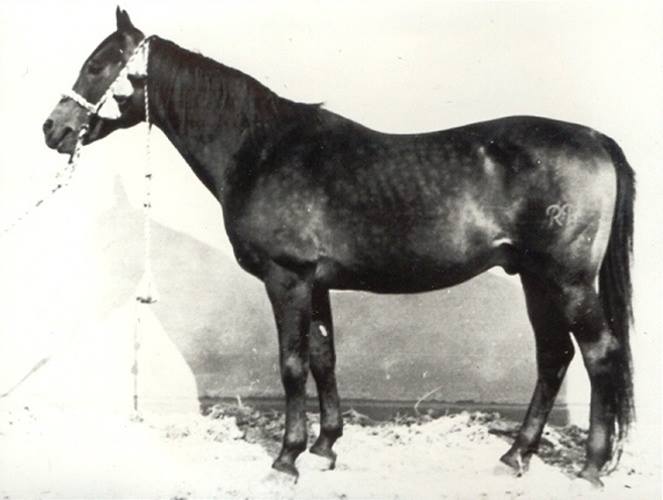
Wielki Szlem
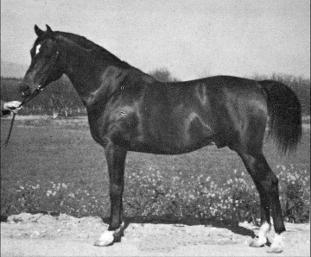
*Witez II
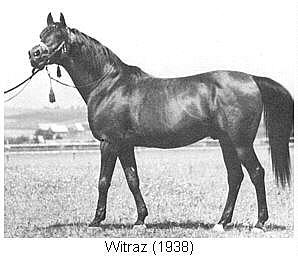
Witraz
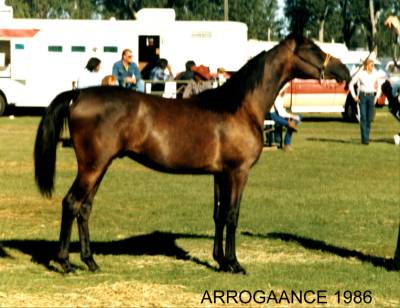
Arrogaance
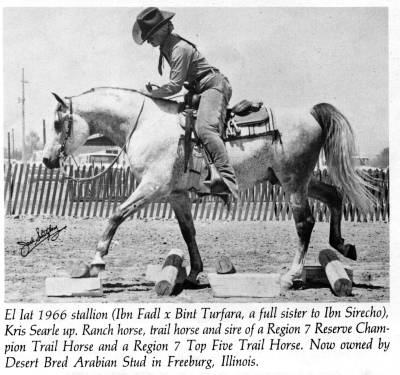
El Iat
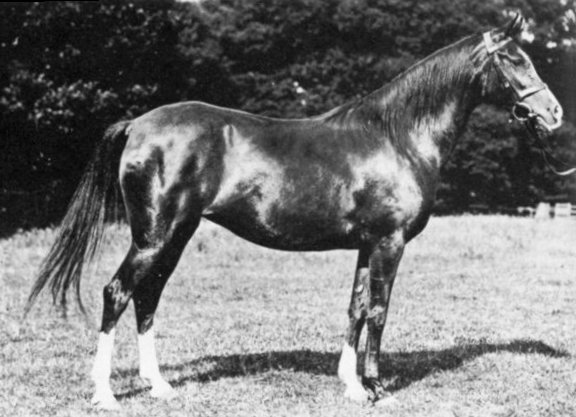
Nasra
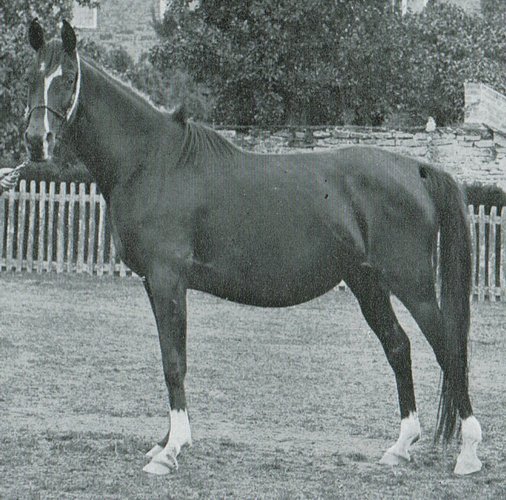
Nefisa
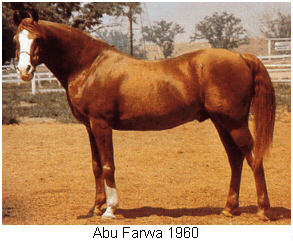
Abu Farwa
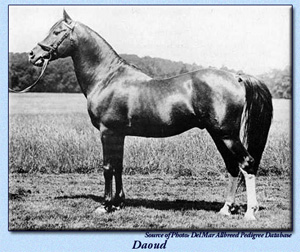
Daoud
